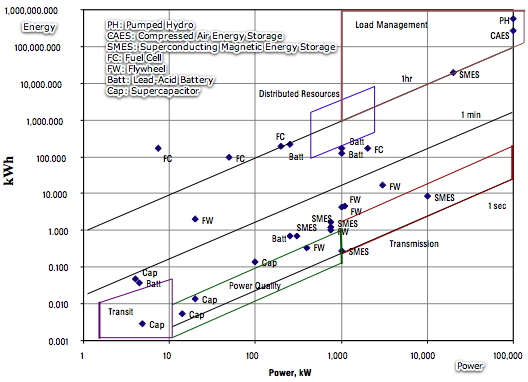This chart is pulled from a good report (pdf) circa 2001 out of Sandia National Labs which is full of nice charts like this one. Energy storage systems have numerous facets you can sort them out over. For example up-front costs, lifetime, cost per cycle, etc. etc. This shows seven different technologies, including superconducting magnets (which I must say do threaten to take the fun-geeky crown from fly wheels). It doesn’t include some very viable and useful storage tech, including sodium batteries, flow batteries, phase change materials such as ice used for daily load leveling, etc. It would be better yet if those were on here, as well as some others that are a bit off to one side; like a train load of coal or a typical LNG tank.

The these are scattered over two metrics. How much power the tech can supply and how much total the tech can store. It’s a shame that there aren’t points in all four corners. I guess the sun kind-a-sort-a goes up above the upper left corner. I assume the dots show existing systems and there large practical areas around those points.
One of the metrics not shown is the maturity of the technology and the market. SMES looks like it’s close or just past solving the major tech-maturity questions. I enjoyed, for example, a fun essay about using the magnets pulled from old medical scanners for energy storage. CAES is ready to build out large market share; but as of yet there aren’t a lot of existing systems. Flywheels are even further along and look like they have lots of potential for sales in the next few years. PH is probably tapped out – i.e. fully built out, at least in the industrialized countries.
Regions of the chart are delimited and labeled to show what applications fall into that region. As the entire system comes under increasing stress power quality applications are going to get a lot of capital. Load management is quite a range of problems: balancing daily load, weekly to monthy variations in solar and wind sources, and seasonal variations from demand or distribution bottlenecks.
The PDF link isn’t correct. Can you fix it? Thanks
Dave – Damn, sorry, fixed, thanks! – ben
Pingback: Using Freight Trains to Store Energy | Ascription is an Anathema to any Enthusiasm